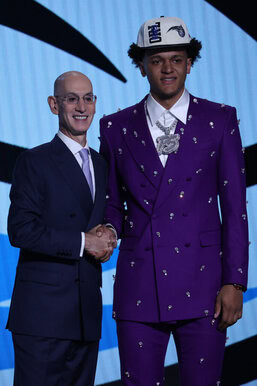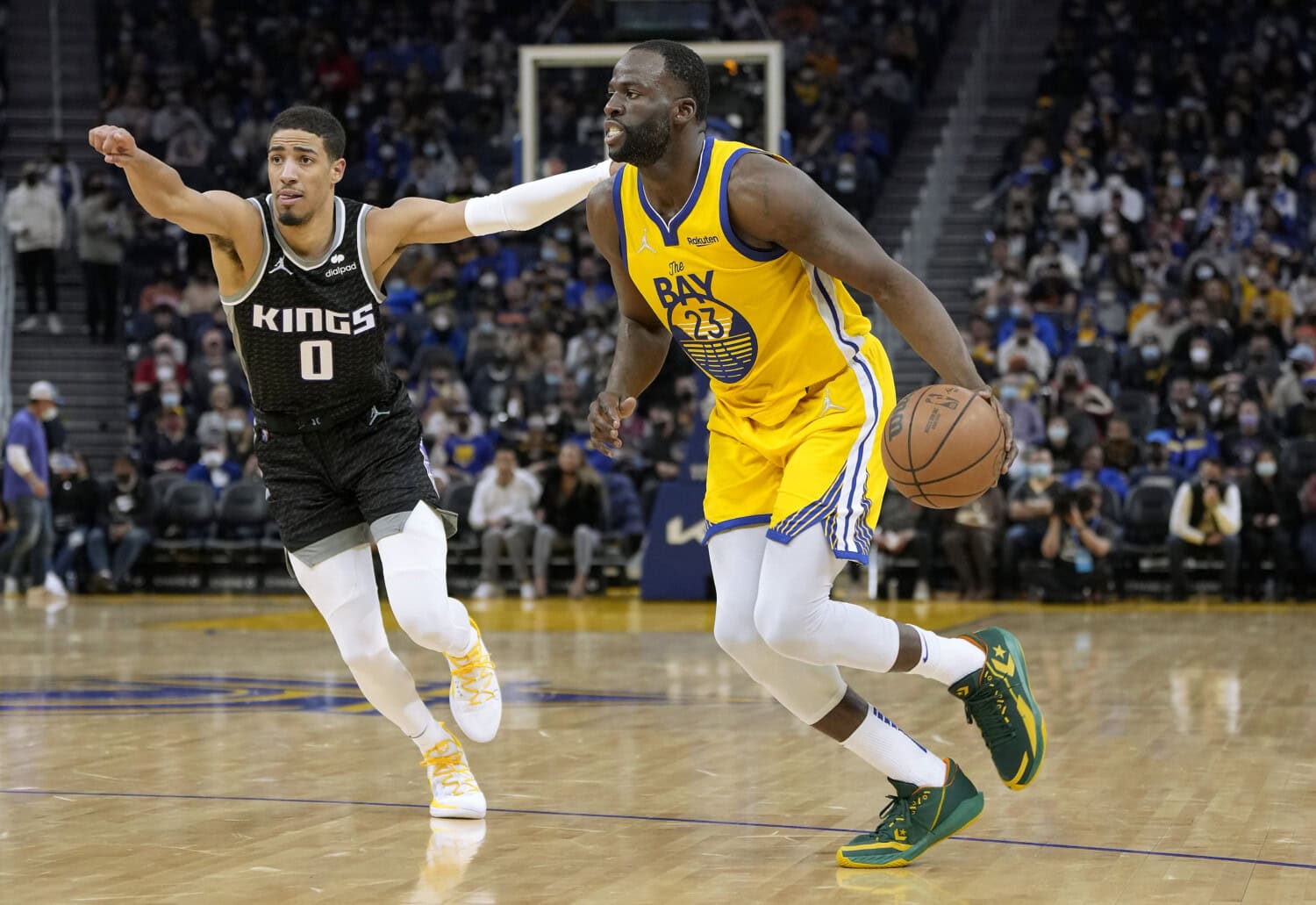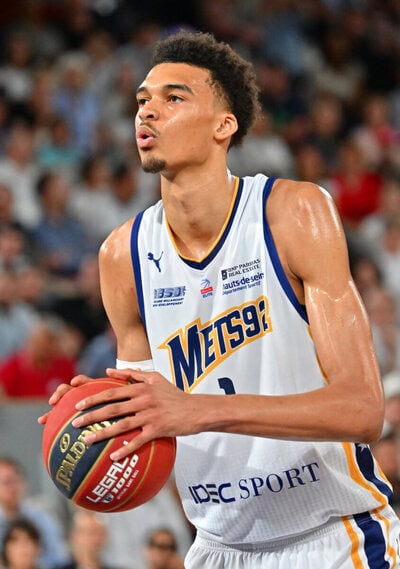In a pool of talent with more depth than ever, how do hoop hopefuls climb from second-round status to lottery land? Boardroom spoke with experts to hear how potential pros best increase their own stock.
They call it the Green Room for a reason.
A year ago in Barclays, Duke phenom Paolo Banchero heard his name called first to the delight of many and the shock of some. After an amazing year in Durham, the do-it-all forward leaped from a surefire top-three pick to a surprise No. 1 selection in what felt like a matter of moments.

Shaking hands with Adam Silver and putting on an Orlando Magic cap, Banchero inked a $50.1 million deal with the Florida franchise.
For reference, Paolo’s sum salary was over $5 million more than that of Chet Holmgrem at No. 2 and almost $10 million more than Jabari Smith at No. 3.
Atop the NBA Draft and all the way into the last picks, the talent margins are often slim, but the payouts prove vast.
Falling from the Top 10 to the second round can mean millions in annual earnings and the difference between guaranteed money and fighting for a roster spot.
So, just why do certain players rise and fall, and what can be done to start one’s professional path on the right foot?
Ahead of the 2023 NBA Draft, Boardroom spoke with experts who operate in the business of maximizing talent. Learn what teams are looking for and how a prospect can best control their own destiny.
Mental Makeup
The game of basketball is more complex and talent-rich than ever before.
Coming off the heels of an NBA postseason where a 7-foot Serbian selected in the second round dominated opponents as a point center, the positionless play of basketball’s best has transformed the hardwood into a chess board. To truly have an impact on both sides of the ball, it’s more than just jumping high and cutting quickly.
One has to see, think, and feel the game in a sharper, smarter, and faster fashion.
“They used to call these things intangibles,” AIQ founder Dr. Scott Goldman told Boardroom. “I think the intangibles are actually measurable.”
AIQ, which stands for Athletics Intelligence Quotient, tests an athlete’s ability to problem-solve and make decisions on the go. In 2023, the game of basketball reads more like a Rubix cube than ever before when considering floor spacing, defensive rotations, and matchup hunting.

The game’s greatest decision-makers, whether trusted veterans or ascending talent, can quickly solve such situations in manners that make them more valuable than a peer with comparable physical measurables.
“Through a player’s eyes, the chaos is more like a synchronized dance,” Goldman says. “You’ll hear players go, ‘It just made sense to me that’s where the game was going.’ That’s intelligence. It’s how well you see that stuff, it’s like going from analog to 4k.”
In a sense, it’s why Draymond Green can play at an elite level despite entering the league as a tweener. It’s why Tyrese Haliburton has made the All-Star team in only his third season.
“A point guard in transition has to identify reads,” Goldman says. “Multiple target search is about being able to scan. Think about a guy who has to scan a jab step and read the body language to know what’s next. Similarly, a ballhandler might need to scan to see where his teammate’s hands might flash.”
To Goldman and many NBA execs, the unseeable measurables revealed by AIQ raise the profile of a pick the same way an inordinate wingspan or an insane vertical jump can. Having an intimate understanding of one’s AIQ scores and the team profiles said skillset fits is a selling point for prospects looking to increase their worth.

When considering last year’s class of NBA entrants, the proof appears to be in the pudding where AIQ is concerned.
“The [2023] All-Rookie Team scored higher on AIQ by over 30 percentile points, which is a massive margin,” says Goldman. “We have positional focus and teams really seem to value that. Improvising and being creative is definitely a cognitive component. As AIQ goes up, the performance goes up in meaningful stats like field goal efficiency, rebounds, and turnover rates.”
Thus far, AIQ has proven an indicator of immediate success and eventual ascent. Like any NBA situation, franchise fit and opportunity often set the stage for an athlete to truly reach their potential.
Take, for instance, Lauri Markkanen, the No. 7 pick in the 2017 NBA Draft. After a somewhat slow start in Chicago and a stop in Cleveland, Markkanen found his way as an All-Star in Utah voted 2023’s Most Improved Player. It is said that he scored strongly in overall AIQ testing and highly in the spatial awareness subset.
What may surprise some is that scores related to spatial awareness and on-the-fly problem-solving are about as certain as height itself. Though the brain can be taught, pattern recognition can be almost innate.

What can be expanded is mindset and approach.
“The newest tool is having guys see a sports psychologist,” NBA performance consultant Adam Quinter told Boardroom.
Quinter, a trainer who played professionally prior to working with the likes of Aaron Gordon, Andrew Wiggins, and countless others, spends the majority of his time improving athletic ability.
However, he’s seen just as impressive gains in growing games by working on players’ minds.
“I have a guy, Zack Hollis,” Quinter says on his preferred sports psychologist. “He’s a younger guy who just got done playing overseas. That’s the next wave. Kevin Love started the mental health wave, but having guys visit a sports psychologist right away as rookies? It’s going to change their perspective on what matters most.”
Consider this: All-time talents like Michael Jordan, Kobe Bryant, and Shaquille O’Neal worked with George Mumford during their title reigns. One has to wonder just how much an edge an incoming rookie could gain by getting on said wave prior to their professional start.
Still, while selling strengths between the ears matters much, it’s the training they implement on their body that impacts draft status the most.
The Agile Athlete
A prospect entering the 2023 NBA Draft is now expected to be able to switch on defense 1 through 5 and stay on the court through the course of a grueling postseason.
“Mobility is half the game,” Quinter says.
Working with MarJon Beauchamp, a player who rose in the ranks of the 2022 NBA Draft to the tune of a first-round selection, Quinter has seen firsthand the demand for the mobile athlete who can defend multiple positions. While nothing tests defense like actual gameplay, there are plenty of exercises leading up to the draft process that can increase one’s aptitude when locking up an opponent and making multiple switches on a single possession.
“Yoga crosses over to basketball so fluidly, especially in a lateral demeanor,” says Quinter. “We’ll spend a lot of time on one leg moving laterally. Their whole defensive game will change right in front of your eyes because nobody focuses on that in the weight room.”
Across the NBA, tall, mobile wings like Beauchamp are a bet that any and every franchise is investing in.

Quinter cites the tall 3-and-D player as the new prototype, which makes sense. In today’s game, if you can’t shoot or defend, you can’t play.
While shooting is all reps and defending is mostly mobility, measurables such as height and athleticism in a vertical- and speed-sense can actually increase with the right trainer — and easily accessible medical assistance.
“If you get a chiropractor to help guide your practice to stand taller so their knees aren’t hurting? You’ll see their verticals jump 2 to 3 inches,” Quinter says. “They’re knocking 3/10 of a second off their 40 just doing that — we haven’t even touched a weight yet.”
Quinter has seen these types of gains take place in active NBA talent as well as high school students at Sierra Canyon. That gap between — eventual NBA lottery lands — is where these minor adjustments often lead to major payouts.
This summer and in many summers to follow, Quinter will work with upcoming talent to make them professionals long before they shake hands with Adam Silver. It’s a process of preparing for a career that’s to be taken seriously like any other six-figure salary occupation.
“Pre-draft is about habits and most of these players come in with terrible habits,” Quinter says. “Usually in their programs, they don’t eat well, they don’t stretch well, and they don’t sleep well. Pre-draft is all about habit-building. Those things can put you ahead of a person from the standpoint of being a professional. If you’re not going to be a professional now when everyone is so good and so athletic? You’re going to break down.”
In an era where every player is uber-athletic and competition comes from all corners of the globe, a business-oriented approach to training, testing, and scheduling is how hoop hopefuls invest in their futures and best raise their ultimate draft status.
Pricing a Prospect
On Thursday night, French phenom Victor Wembanyama will hear his name called first in the 2023 NBA Draft.
Set to make multiple millions over the course of his rookie contract, Wemby’s height sets a ceiling that can’t be coached. Standing well above 7 feet tall, his status as a lottery land was well cemented months before the big night at Barclays.
For every other prospect in this year’s draft and the many more to come, it will take more than just talent to achieve their draft dreams, but a dedication to the professional lifestyle long before it.
“You have to have discipline,” Quinter says. “They should all be on Google Scheduler just like a real job. You should be busy all day long doing something that’s related to your job. Because if you’re not and don’t take it seriously? There’s another man that’s going to take your job.”

From focusing on important combine drills such as vertical leap and shuttle test to tracking sleep and strain with wearable tech tools like WHOOP, maximizing measurables and recovery time all impact playing at the highest level and being paid to do so.
These high-level habits are part of being picked as a pro and seizing staying power.
“When it comes to sports, there’s no way you’re going to have a successful career if you’re not doing the right things,” says Quinter. “They’re running Ferraris where we used to be running Corollas. Every single guy now is athletic.”
As explained earlier, today’s players are expected to be Ferraris with Tesla computer screens in each dashboard.
Selling speed, spacial awareness, and ability to read a defense are all expected of a prospect presenting themselves to teams.
Sometimes it means maximizing testing scores and crushing workouts. Other times, it all comes to meeting with the right teams to find the perfect place to best flourish — whether the big payday comes on draft day or seasons after one’s NBA arrival.
“When you really know the player, you can make well-informed decisions,” Goldman says. “There was a late draft pick who really developed in his team’s system [based on his AIQ.]
“He just signed a max contract.”